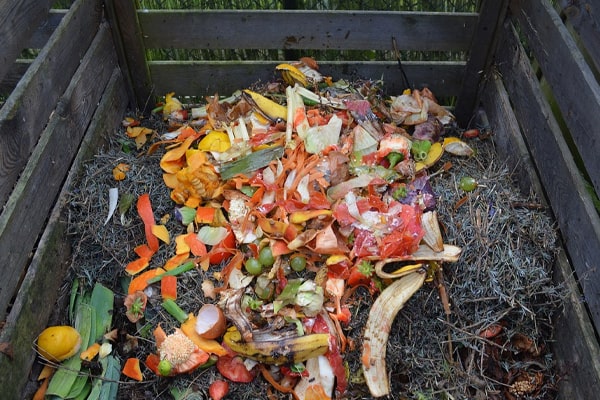Composting takes the burden away from landfills; it’s an incredibly effective and eco-friendly way of utilizing unwanted yard waste. In fact, backyard composting will reduce your household waste by a whopping 50% to 75%. Now imagine if all people would turn their garden scraps into compost, the impact to the environment would be astounding, to say the least.
The backyard is the perfect spot for composting because the air circulation and temperature are just right to “cook” the compost. In addition, the backyard’s almost always near a water source, which will come in handy once the compost needs the extra boost of moisture.
Contents []

If you’d like to make your own compost, there are certain factors that you should consider first. Composting isn’t just about piling on kitchen scraps willy-nilly. There are certain types of scraps that could be used for the compost as well as scraps that must never be added to a compost bin. In this guide, we are outlining the many composting dos and don’ts that you should keep in mind before making your own backyard compost pit:
Composting DO’s
DO Start on Bare Earth
If you are making a compost pile, it’s better to dig one on bare earth as opposed to using a plastic bin (the latter could be convenient for some spaces, however). Organisms such as earthworms are needed to process the compost heap and make the nutrients available for plants to absorb. Since you are working on bare earth, the earthworms could get into the compost pile easily.
DO Promote Proper Air Circulation
Aeration is paramount to composting. You want to make sure that the organic matter is not too wet, not too compact, or overheating. By turning the compost pile regularly, excess moisture evaporates, compaction is avoided, and overheating is prevented. Turning the compost also boosts oxygen, which will help break down the organic matter.
Compost piles generate heat naturally as the microbes process the organic matter. But too much heat could kill these beneficial microbes, which could affect the decomposition of the organic matter. Promoting proper air circulation ensures that the heat is evenly distributed in the compost, which will improve the quality of the compost pile itself.
DO Build a Compost Pile near a Water Source
Proper hydration is a great way to maintain the ideal range for decomposition. If the compost pile is too dry, the organic matter will not break down easily. It takes about 2 months to 2 years for a compost pile to break down completely. If the compost pile is too dry, the waiting period will stretch to several months. By boosting the moisture level in the compost, the organic matter will break down at a much faster rate. So if it’s possible, always set your compost pile near a water source. This way, adding moisture to the pile will be less of a hassle for you.

DO Diversify
What kind of organic matter could you add to your compost pile? A good compost pile is comprised of green and brown materials. Green materials are packed with nitrogen while brown materials are loaded with carbon. These nutrients enrich the soil and promote proper plant growth.
Use different types of organic materials to create healthy compost. For food scraps, add fruits and vegetable peels, eggshells, coffee grounds, tea bags, and nutshells. You could also mix shredded cardboard and newspaper in the compost heap. Yard waste such as grass clippings, houseplants, as well as dried leaves, sawdust, wood chips, and yard trimmings make excellent materials for composting.
Never add pet droppings, dirty cat litter, diseased or infected plants, and chemically treated yard trimmings because these will cause pathogens to spread all over the yard. We recommend pilling the brown layer on top of the green layer. This will help mask the smell of decomposing compost materials and keep flies away.
Composting Don’ts
Don’t Leave the Compost Bin Uncovered
If you are making compost using a bin, always keep the bin covered. This goes especially if you are mixing food scraps into the compost because these will attract all sorts of pests and animals! When covering your compost bin, be sure to weigh the cover down with cinder blocks or heavy woodblocks.
Do not Add Certain Food Scraps
Contrary to popular notion, not all food scraps could be used for composting. Leftover meats, bones, lard, fish, cooking oil, and broken eggs are not ideal for composting because these food scraps produce a stench that would attract pests like rodents, cockroaches, and flies! Dairy products are not ideal for composting because these foods will produce a bad smell that could put people off or attract pests/animals.
Do Not Compost Certain Yard Wastes
Not all yard wastes are ideal for composting. Diseased plants, weeds, wet grass, and coal ashes are not suitable for composting because these could release pathogens that could harm the health of your garden or yard.
Don’t Let the Compost Get too Wet or Dry
To maintain a healthy compost, the conditions must be right. Excessive heat or moisture could delay the break down of the organic matter. The key is to keep the compost moist and moderately warm, not wet and overheated. We suggest covering up your compost pile with plastic sheeting to keep the temperature and moisture level in check. By covering your compost pile, it’s also protected from the rain and sun exposure. Always protect the compost pile from the elements.
Always check the compost pile for moisture. If it is too dry, moisten the pile. If it is too wet, add more composting material. If you are adding dry materials to your compost, you have to moisten the materials first. Bury the vegetable and fruit wastes at least 10 inches under the compost waste so these will break down efficiently.



